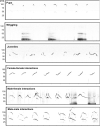Translating mouse vocalizations: prosody and frequency modulation
- PMID: 20497235
- PMCID: PMC2936813
- DOI: 10.1111/j.1601-183X.2010.00603.x
Translating mouse vocalizations: prosody and frequency modulation
Abstract
Mental illness can include impaired abilities to express emotions or respond to the emotions of others. Speech provides a mechanism for expressing emotions, by both what words are spoken and by the melody or intonation of speech (prosody). Through the perception of variations in prosody, an individual can detect changes in another's emotional state. Prosodic features of mouse ultrasonic vocalizations (USVs), indicated by changes in frequency and amplitude, also convey information. Dams retrieve pups that emit separation calls, females approach males emitting solicitous calls, and mice can become fearful of a cue associated with the vocalizations of a distressed conspecific. Because acoustic features of mouse USVs respond to drugs and genetic manipulations that influence reward circuits, USV analysis can be employed to examine how genes influence social motivation, affect regulation, and communication. The purpose of this review is to discuss how genetic and developmental factors influence aspects of the mouse vocal repertoire and how mice respond to the vocalizations of their conspecifics. To generate falsifiable hypotheses about the emotional content of particular calls, this review addresses USV analysis within the framework of affective neuroscience (e.g. measures of motivated behavior such as conditioned place preference tests, brain activity and systemic physiology). Suggested future studies include employment of an expanded array of physiological and statistical approaches to identify the salient acoustic features of mouse vocalizations. We are particularly interested in rearing environments that incorporate sufficient spatial and temporal complexity to familiarize developing mice with a broader array of affective states.
© 2010 The Authors. Genes, Brain and Behavior © 2010 Blackwell Publishing Ltd and International Behavioural and Neural Genetics Society.
Figures


Similar articles
-
Studying Socio-Affective Communication in Rats through Playback of Ultrasonic Vocalizations.Curr Protoc Neurosci. 2016 Apr 8;75:8.35.1-8.35.17. doi: 10.1002/cpns.7. Curr Protoc Neurosci. 2016. PMID: 27063787
-
Rats selectively bred for low levels of 50 kHz ultrasonic vocalizations exhibit alterations in early social motivation.Dev Psychobiol. 2008 May;50(4):322-31. doi: 10.1002/dev.20294. Dev Psychobiol. 2008. PMID: 18393285
-
Ultrasonic vocalizations of adult male Foxp2-mutant mice: behavioral contexts of arousal and emotion.Genes Brain Behav. 2016 Feb;15(2):243-59. doi: 10.1111/gbb.12274. Epub 2016 Jan 13. Genes Brain Behav. 2016. PMID: 26566793
-
Rat 50-kHz ultrasonic vocalizations as a tool in studying neurochemical mechanisms that regulate positive emotional states.J Neurosci Methods. 2018 Dec 1;310:33-44. doi: 10.1016/j.jneumeth.2018.06.018. Epub 2018 Jun 26. J Neurosci Methods. 2018. PMID: 29959002 Review.
-
Rats that learn to vocalize for food reward emit longer and louder appetitive calls and fewer short aversive calls.PLoS One. 2024 Feb 9;19(2):e0297174. doi: 10.1371/journal.pone.0297174. eCollection 2024. PLoS One. 2024. PMID: 38335191 Free PMC article. Review.
Cited by
-
Beyond the three-chamber test: toward a multimodal and objective assessment of social behavior in rodents.Mol Autism. 2022 Oct 25;13(1):41. doi: 10.1186/s13229-022-00521-6. Mol Autism. 2022. PMID: 36284353 Free PMC article. Review.
-
Social behavior in a genetic model of dopamine dysfunction at different neurodevelopmental time points.Genes Brain Behav. 2015 Sep;14(7):503-15. doi: 10.1111/gbb.12233. Epub 2015 Aug 25. Genes Brain Behav. 2015. PMID: 26176662 Free PMC article.
-
Ultrasonic vocalizations in mice: relevance for ethologic and neurodevelopmental disorders studies.Neural Regen Res. 2021 Jun;16(6):1158-1167. doi: 10.4103/1673-5374.300340. Neural Regen Res. 2021. PMID: 33269765 Free PMC article. Review.
-
The structure and usage of female and male mouse ultrasonic vocalizations reveal only minor differences.PLoS One. 2012;7(7):e41133. doi: 10.1371/journal.pone.0041133. Epub 2012 Jul 17. PLoS One. 2012. PMID: 22815941 Free PMC article.
-
Juvenile Shank3b deficient mice present with behavioral phenotype relevant to autism spectrum disorder.Behav Brain Res. 2019 Jan 1;356:137-147. doi: 10.1016/j.bbr.2018.08.005. Epub 2018 Aug 19. Behav Brain Res. 2019. PMID: 30134148 Free PMC article.
References
-
- Alleva E, Fasolo A, Lipp HP, Nadel L, Ricceri L. Behavioural brain research in naturalistic and semi-naturalistic settings. Kluwer Academic Publishers; Dordrecht, The Netherlands: 1994.
-
- Alpert M, Rosenberg SD, Pouget ER, Shaw RJ. Prosody and lexical accuracy in flat affect schizophrenia. Psychiatry Res. 2000;97:107–118. - PubMed
-
- Amorosa H. Disorders of vocal signaling in children. In: Papousek U, Jurgens U, Papousek M, editors. Nonverbal vocal communication: Comparative and developmental approaches. Cambridge University Press; Cambridge, UK: 1992. pp. 192–204.
-
- Bach DR, Buxtorf K, Grandjean D, Strik WK. The influence of emotion clarity on emotional prosody identification in paranoid schizophrenia. Psychol Med. 2009;39:927–938. - PubMed
Publication types
MeSH terms
Grants and funding
LinkOut - more resources
Full Text Sources

